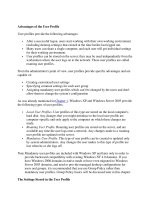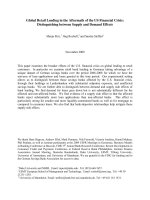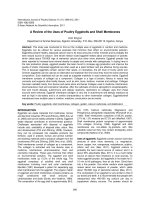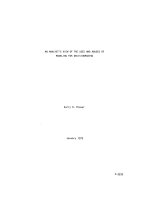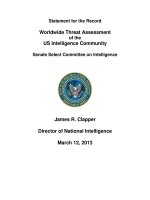education of the US
Bạn đang xem bản rút gọn của tài liệu. Xem và tải ngay bản đầy đủ của tài liệu tại đây (563.36 KB, 32 trang )
<span class='text_page_counter'>(1)</span>EDUCATION IN THE U.S.. Lecturer: Ly Thi Hoang Men.
<span class='text_page_counter'>(2)</span> CONTENT . History and. . System. . Education. . Achievemen. . Challenges. . Beliefs. development of. education. philosophy. ts. values in education. and.
<span class='text_page_counter'>(3)</span> HISTORY AND DEVELOPMENT . 1. 642: first steps toward establishing a system of public school in Massachusetts . 1. 647: Mass. passed law required every town to provide children with schools and schoolmasters ext 40 years: all colonies followed Mass.. N.
<span class='text_page_counter'>(4)</span> HISTORY AND DEVELOPMENT E. nd of 17th century: citizens of English Colonies were to be educated;. children. to. be. prepared. for. conducting. political, economic, and religious affairs of colonies. A. fter American independence in 1783: education developed rapidly. (school. districts,. well-equipped. schools,. professional educators and educational administrators).
<span class='text_page_counter'>(5)</span> HISTORY AND DEVELOPMENT 1. 787: Northwest Ordinance mandated each township in Northwest Territory to reserve at least a mile square for educational. purpose. and. required. each. state. to. establish public higher education institutions. homas Jefferson(1801-09) urged Virginia law makers to implement the plan for “More General Diffusion of Knowledge”.. T.
<span class='text_page_counter'>(6)</span> HISTORY AND DEVELOPMENT . A. . 1. fter 1860s: education became compulsory. 870: 6.5 mill. 5-16 year olds in public schools (57% school-age children and youths) 880: 15.5 mill. (72% school-age children and youths). 1.
<span class='text_page_counter'>(7)</span> HISTORY AND DEVELOPMENT arly 20th century: teaching transformed into “women’s profession” and fundamental assumptions about American education system shaped (how schools are organized, who they serve, how they are staffed).
<span class='text_page_counter'>(8)</span> HISTORY AND DEVELOPMENT ollege & university enrollment (in 194 194 196 196 197 197 198 200 million) 0 6 1 9 4 9 9 3 1.5. 2.0. 4.0. 8.0. 10. 0. 11. 6. 13. 5. 17. 5.
<span class='text_page_counter'>(9)</span> SYSTEM OF EDUCATION Postgraduate Studies. Doctor’s Degree. Graduate Studies. Master’s Degree. Undergraduate Studies. Bachelor’s Degree. Senior High School. Grades 9 – 12. Junior High School. Grades 6 – 8. Elementary School. Grades 1 – 5. Kindergarten. 4 – 5 years old. Nursery School. 2 -3 years old.
<span class='text_page_counter'>(10)</span> STRUCTURE Education is divided into 3 stages: -Elementary education -Secondary education -Higher education Elementary and Secondary education is compulsory.
<span class='text_page_counter'>(11)</span>
<span class='text_page_counter'>(12)</span> STRUCTURE . Elementary and. Secondary education is free at public schools. . Higher. . Education. . Public. education requires tuition fee. has. two sectors: public and private school. systems are supported by a combination of local, state, and federal government funding..
<span class='text_page_counter'>(13)</span> STRUCTURE C. urriculum decisions in public schools are made largely at. the. local. and. state. levels. by. local. board. of. education. ll public school systems are required to provide an education free of charge to everyone of school age in their districts (85% children). A.
<span class='text_page_counter'>(14)</span> STRUCTURE Privat e schools may be of 2 kinds institutions privately owned and operated institutions run by religious organization At private schools, children have to pay for education but charge rates vary depending on geographic location, the school's expenses, and the availability of funding from sources other than tuition..
<span class='text_page_counter'>(15)</span> STRUCTURE rivate schools cater for different needs: - college-bound students - gifted students - students with learning disabilities or other special needs - students with specific religious affiliations..
<span class='text_page_counter'>(16)</span> STRUCTURE . H. igher education refers to undergraduate and graduate studies. ndergraduate studies commonly consists of four years of study leading to a Bachelor’s degree. U.
<span class='text_page_counter'>(17)</span> STRUCTURE H.E. institutions: - Community College (Junior College) - Liberal Arts College - University - Professional School - Institute of Technology and Technical School.
<span class='text_page_counter'>(18)</span> STRUCTURE dmissions criteria for undergraduate studies at college or university are: - Rigorous curriculum in high school - Students’ GPA - Class ranking - Standardized test scores (Such as the SAT or the ACT tests). -. Essay. -. Other achievements. -. Interview.
<span class='text_page_counter'>(19)</span> STRUCTURE Graduate. studies. are. conducted. after. obtaining an initial degree and sometimes after several years of professional work leading to a more advanced degree such as a Master's degree or a Doctor’s degree (Ph.D. or others)..
<span class='text_page_counter'>(20)</span> STRUCTURE Entrance into graduate programs usually depends on: - Student's undergraduate academic performance - Professional experience - Standardized test scores: GRE(general), GMAT(business), LSAT(law), MCAT (medicine).
<span class='text_page_counter'>(21)</span> EDUCATION PHILOSOPHY Education is universal Education is decentralized Education is comprehensive Education is professional Education pays attention to both intellectual development and character building Education is of practical value.
<span class='text_page_counter'>(22)</span> EDUCATION PHILOSOPHY . E. ducation system is universal: Children within an age range have right to education services which are supported by public taxation. . E. ducation system is decentralized: No federal authority to organize and oversee a national education system with a uniform curriculum requirements or uniform standards for both teacher and student qualifications. Funding and administration are responsibilities of local or state governments..
<span class='text_page_counter'>(23)</span> EDUCATION PHILOSOPHY. E. ducation is comprehensive: Schools offer a variety of options that reflect the diversity of interests and abilities of students. E ducation is professional: Education is managed and serviced by professional educators and administrators E ducation pays attention to both intellectual development and character building: Beside rigorous academic curriculum are many extracurricular activities. E ducation is of practical value.
<span class='text_page_counter'>(24)</span> ACHIEVEMENTS . P. roviding education for great proportion of population (1940: 38% 25-29 year olds got H.S. diploma & 6% got coll. Degree compared with 1985: 86% 25-29 year olds got H.S. diploma & 22% got coll. Degree) roducing proportionately more college students than any industrial nations (1981: 32% had college education; Canada: 17.2%; Sweden: 15.5%; Japan: 14.5%). P.
<span class='text_page_counter'>(25)</span> ACHIEVEMENTS A ssuring high quality education: Prestigious universities, Nobel prize holders and leading scientists, highly qualified labor force, international students O ffering equal opportunity for education to all citizens including the under-privileged (2003 literacy rate: 97% & 95% 14-17 year olds attend H.S.) M inimizing discrimination: Affirmative action; federal funding; accommodation of handicapped students.
<span class='text_page_counter'>(26)</span> CHALLENGES Confli cts about bilingual and multicultural education. Inequ ality (rich vs. poor areas) Existe nce of racial discrimination Decli ne in quality in elementary and secondary education (1983 report – A Nation at Risk).
<span class='text_page_counter'>(27)</span> CHALLENGES S hortage of teaching staff esp. math and science teachers D rop-out rates esp. among minority students V iolence and other negative practices.
<span class='text_page_counter'>(28)</span> BELIEFS & VALUES IN EDUCATION . E. . E. ducation forms the foundation of democracy. ducation is the means by which the values of equality of opportunity and competition are exercised ducation promotes individual freedom and self-reliance. E.
<span class='text_page_counter'>(29)</span> BELIEFS & VALUES IN EDUCATION Education. realizes. the. values. of. material. wealth and hard work Education helps to fulfill American Dream Education forms the foundation of democracy: educated citizens are able to govern the country and protect democracy..
<span class='text_page_counter'>(30)</span> BELIEFS & VALUES IN EDUCATION Education is the means by which the values of equality of opportunity and competition are exercised: - Public school system: open to all; tax-supported. - Education ladder: climb as high as one can Education promotes individual freedom and self-reliance: - encourages and helps students to reach their maximum potential - motivates people to seek higher status - develops students’ critical thinking skills and other personal and social skills.
<span class='text_page_counter'>(31)</span> BELIEFS & VALUES IN EDUCATION ducation realizes the values of material wealth and hard work.. ducation helps to fulfill American Dream: become rich and powerful with high education..
<span class='text_page_counter'>(32)</span>
<span class='text_page_counter'>(33)</span>


